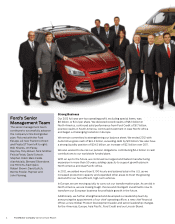Ford 2012 Annual Report Download - page 15
Download and view the complete annual report
Please find page 15 of the 2012 Ford annual report below. You can navigate through the pages in the report by either clicking on the pages listed below, or by using the keyword search tool below to find specific information within the annual report.
Ford Motor Company | 2012 Annual Report 13
Management's Discussion and Analysis of Financial Condition and Results of Operations
13
Trade Policy. To the extent governments in various regions erect or intensify barriers to imports, or implement
currency policy that advantages local exporters selling into the global marketplace, there can be a significant negative
impact on manufacturers based in markets that promote free trade. While we believe the long-term trend is toward the
growth of free trade, we have noted with concern recent developments in a number of regions. In Asia Pacific Africa,
for example, the recent dramatic depreciation of the yen significantly reduces the cost of exports into the United States,
Europe, and other global markets by Japanese manufacturers. Over a period of time, the emerging weakness of the
yen can contribute to other countries pursuing weak currency policies by intervening in the exchange rate markets.
This is particularly likely in other Asian countries, such as South Korea. As another example, government actions in
South America to incentivize local production and balance trade are driving trade frictions between South American
countries and also with Mexico, resulting in business environment instability and new trade barriers. We will continue
to monitor and address developing issues around trade policy.
Other Economic Factors. The eventual implications of higher government deficits and debt, with potentially higher
long-term interest rates, could drive a higher cost of capital over our planning period. Higher interest rates and/or taxes
to address the higher deficits also may impede real growth in gross domestic product and, therefore, vehicle sales over
our planning period.
Trends and Strategies
We remain firm in our belief that our continued focus on executing the four key priorities of our One Ford plan
enables us to go further for our customers, dealers, suppliers, employees, shareholders, and other key constituencies:
• Aggressively restructure to operate profitably at the current demand and changing model mix;
• Accelerate development of new products our customers want and value;
• Finance our plan and improve our balance sheet; and
• Work together effectively as one team, leveraging our global assets.
Despite the external economic environment in recent years, we have made significant progress in transforming our
business.
Aggressively Restructure to Operate Profitably
Brands. In recent years, we have eliminated a number of brands from our portfolio in order to devote fully our
financial, product development, production, and marketing and sales and services resources toward further growing
our core Ford and Lincoln brands. We sold Aston Martin, Jaguar, Land Rover, and Volvo, and we discontinued the
Mercury brand and further reduced our stake in Mazda. In 2012, we announced the revitalization of Lincoln reflecting
the brand's distinct product strategy, including its own dedicated design studio, separate creative agency in New York,
and financial services team to complement the vehicle acquisition and ownership experience.
Manufacturing. We are committed to maintaining an appropriate manufacturing footprint in markets around the
world, both in the more mature markets in which we have an established presence, and in fast-growing newly-
developed and emerging markets. We are making substantial investments in newly-developed and emerging
markets, including in China, India, and Thailand to increase our production capacity with flexible new manufacturing
plants. We and our unconsolidated affiliates in Asia Pacific Africa launched two new plants in 2012, and have
announced that we expect to complete seven more plants in the region by mid-decade. We also are making
substantial investments in North America to grow production as industry sales rebound, including the addition of
400,000 annual incremental units of production capacity during 2012 and significant hiring in the United States as part
of our manufacturing capacity expansions.
In October 2012, we also announced our plan to transform our European operations in response to structural
industry overcapacity in the region. Our plan targets all areas of the business, including product, brand, and cost. We
have detailed an aggressive product acceleration in Europe, including plans to introduce 15 global vehicles within five
years; we are taking steps to further strengthen our brand, and to enhance brand awareness in fast-growing emerging
markets within the region; and we are moving to ensure a more efficient manufacturing footprint. As announced, we
intend to close three European manufacturing facilities, which would affect approximately 6,200 positions. Our intent to
close our assembly plant in Genk, Belgium is subject to an information and consultation process with employee
representatives, which we have commenced. See "Outlook" for additional discussion of our European transformation
plan.
For more information visit www.annualreport.ford.com
























